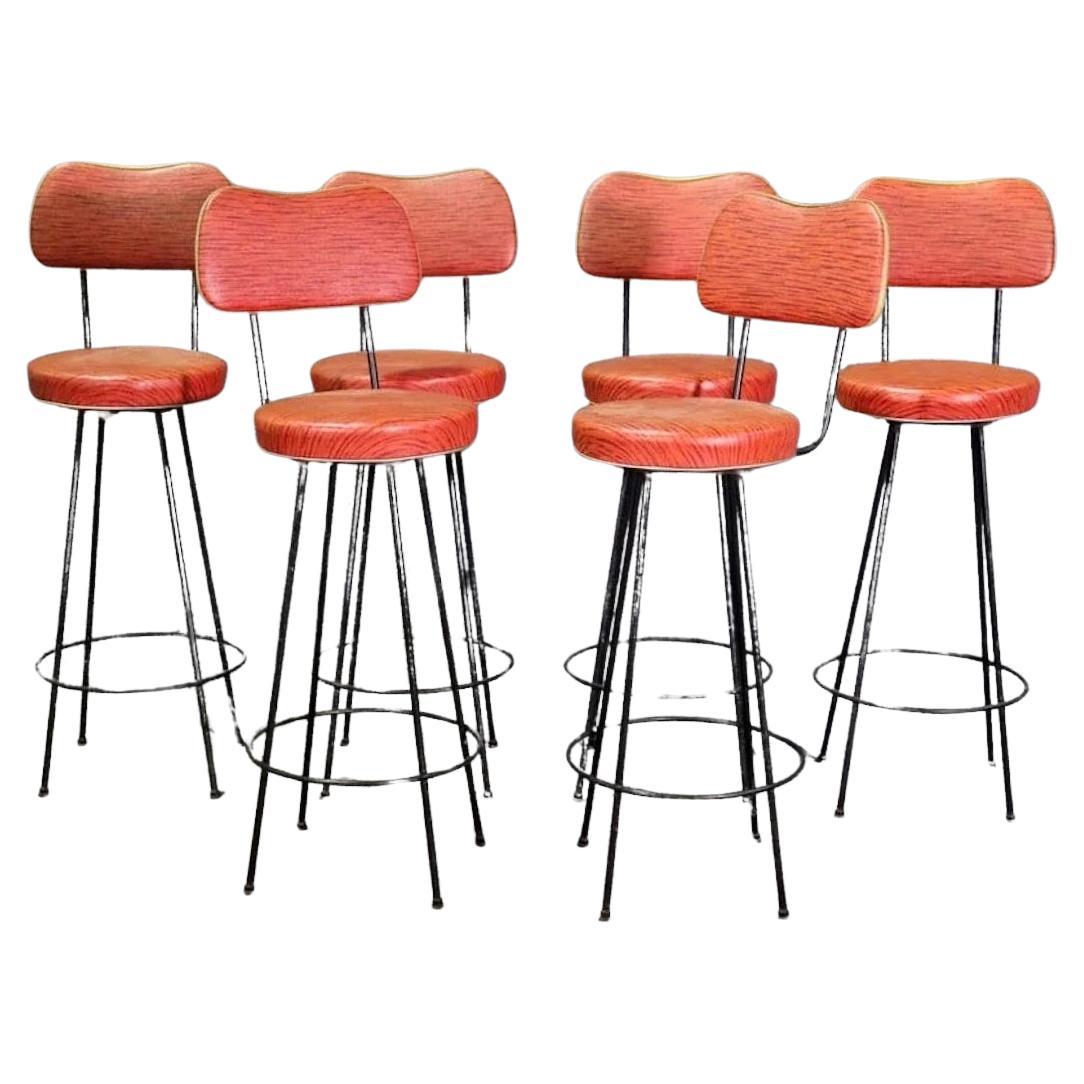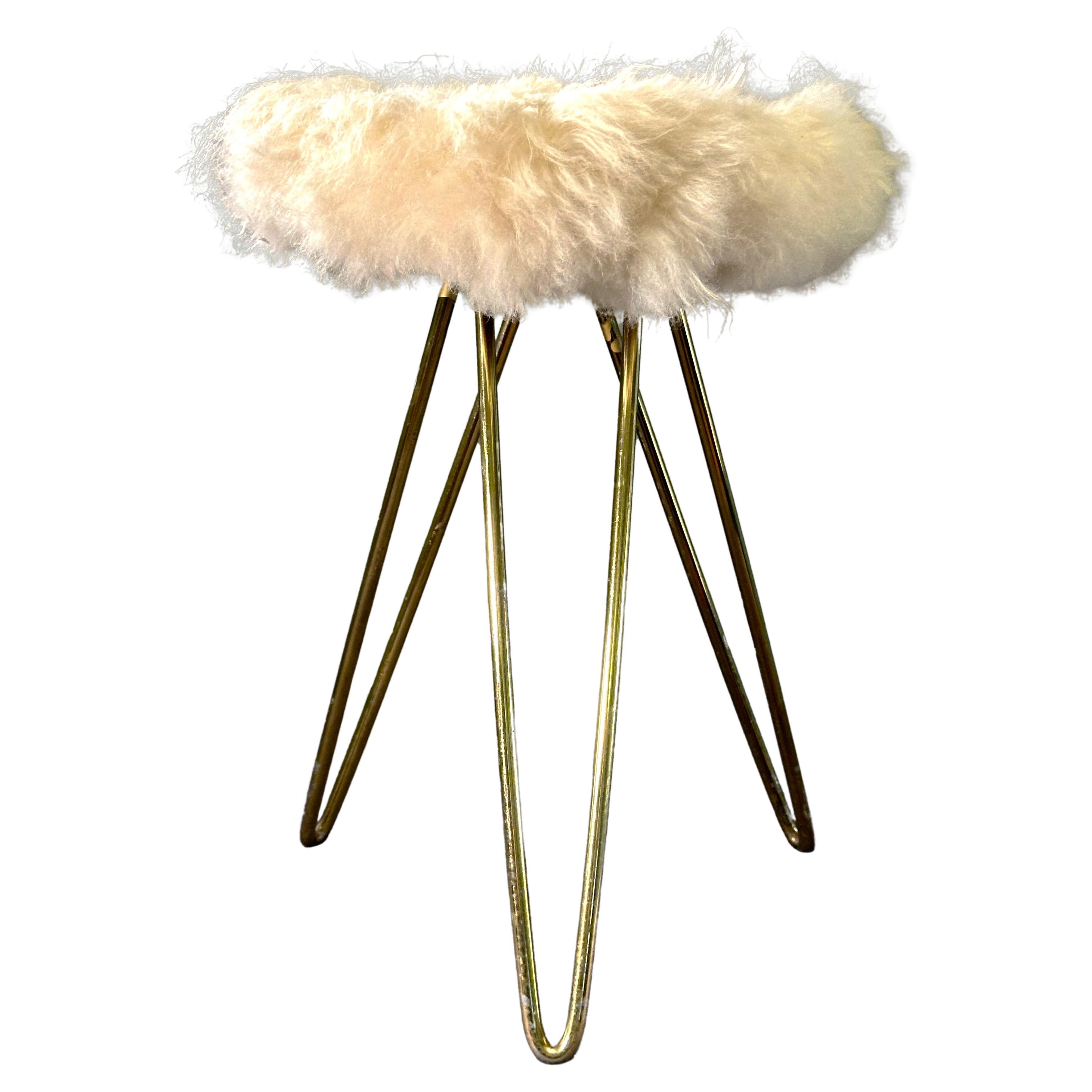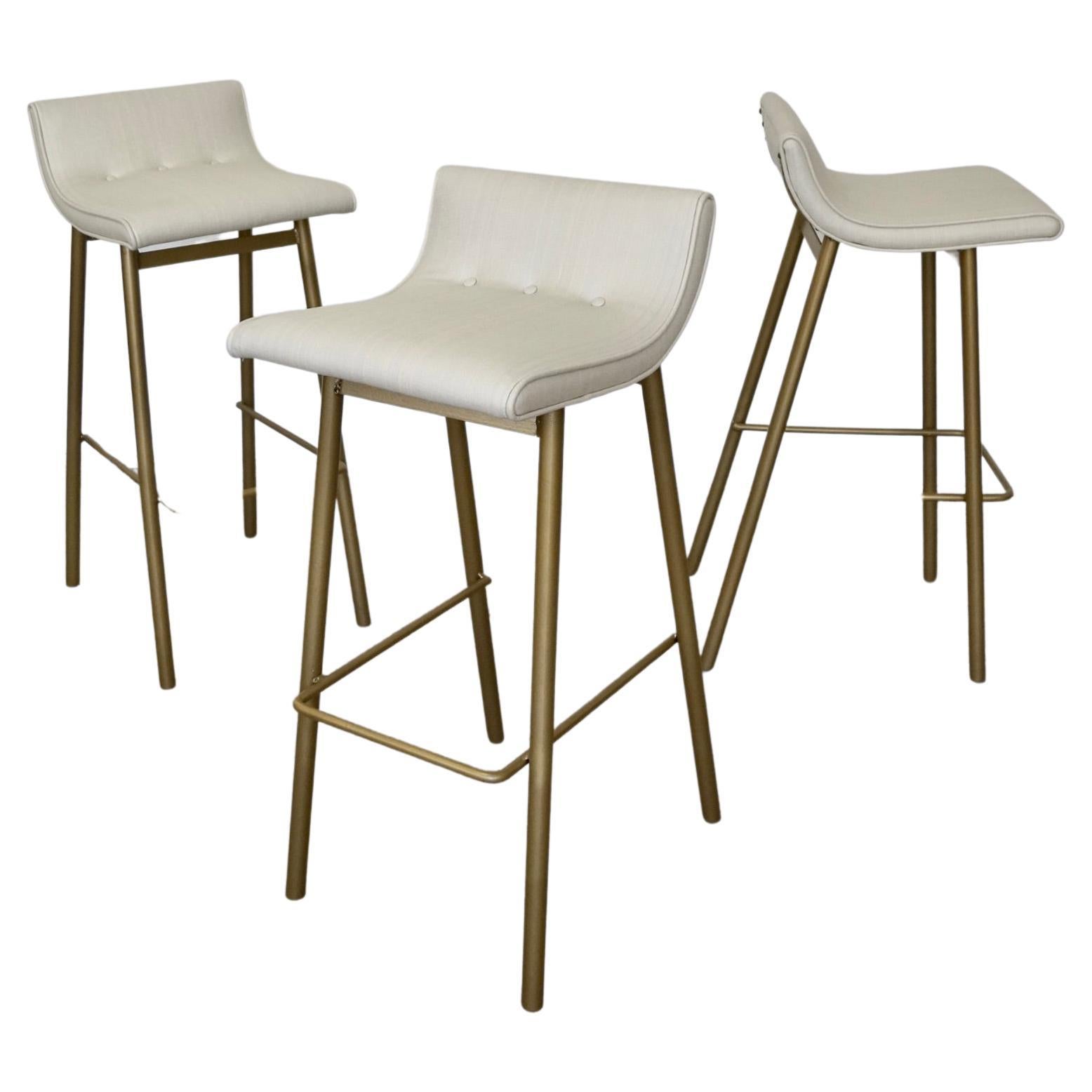Items Similar to SET of SIX mid-century STOOLS by Günter Talos Vienna or pin legs ar. 1950
Want more images or videos?
Request additional images or videos from the seller
1 of 20
SET of SIX mid-century STOOLS by Günter Talos Vienna or pin legs ar. 1950
About the Item
Six mid-century stools designed and made in Vienna around 1950 by J. A. Talos, Vienna XII. Bezirk , Dörfelstraße 6-8 .
The architectually significant and quite representative building is still existing and under monument protection - the company existed until between 1976 and 1978 according the senior Owner the Cabinet Maker Anton Griessler - just opposite the road who´s son was so kind to give me those informations on the phone.
- ... we love to do researches !
designed by Günter Talos.
The company produced high quality iron furniture and was having the honour in taking part in the Werkbundausstellung 1930
The triangular seat is covered with its original red leatherette and as a special featuret they have a solid round and rounded straight chromed ornament in its middle - solid steel chromed hairpin legs
Vintage condition is very good with some signs of age.
Dimensions:
Width 40cm
Depth 40 cm
Height 46 cm
Seat height 46 cm.
Weight: 4.5 Kg / each
shipped in 2 custom made boxes 3 stools each for a maximum of safety
For people interested in the fascinating Viennese History of Art / Art and Design of the early 20th Century:
Werkbund Exhibition 1930
Werkbund Vienna
The Werkbund Wien was an association of artists, industrialists and craftsmen that split off from the Österreichischer Werkbund, founded in 1912, in 1921 under the leadership of Josef Hoffmann and reunited with it in May 1928. The latter was dissolved by the National Socialists in 1938.
History
In 1920, on the occasion of an exhibition in the Vienna Museum of Art and Industry, the fundamental discussion flared up again as to whether the Austrian Werkbund should be oriented towards arts and crafts or whether serial, industrial production based on artistic designs should be the decisive factor. This discussion had been initiated by the art critics Arthur Rössler and Hans Tietze; the latter spoke of "a thousand cute things" in view of the elitist arts and crafts of the Wiener Werkstätte. Josef Frank supported their attitude, but did not attack Josef Hofmann personally. Josef Hofmann and his followers flatly rejected modern industrialization tendencies and wanted to see arts and crafts as traditional and elitist. The dispute led to the Vienna Werkbund splitting off from the Austrian Werkbund in May 1921.
Josef Hofmann and a large part of the board members henceforth formed the Werkbund Wien, which was incorporated as an association into the Deutscher Werkbund; the first president became Margarethe Stonborough-Wittgenstein, Ludwig Wittgenstein's sister. In the "old" Werkbund, the architect Robert Oerley took over the office of president.
Due to the personal union with the director of the Wiener Werkstätte, Josef Hofmann, the Werkbund Vienna remained in its infancy and did not achieve any particular effectiveness.[3] In 1925, on the occasion of the Austrian participation in the exhibition at the exposition des arts décoratifs et industriels modernes in Paris, the two groups came closer again and Josef Hofmann took over the artistic direction. He designed the pavilion, Josef Frank created the coffee house in front of it, Oskar Strnad an "organ tower" and Peter Behrens a glass house, so that representatives of all groupings were involved.
Starting in 1926, talks were held about reunification, which was finally accomplished in May 1928: The Vienna Werkbund rejoined the Austrian Werkbund. Hermann Neubacher, head of the Gemeinwirtschaftliche Siedlungs- und Bauaktiengesellschaft GESIBA, mayor of Vienna from 1938 and close to the German nationalist camp[4], was elected president, and the painter László Gábor was elected executive board member. Josef Frank and Josef Hofmann became vice presidents.
Under the artistic direction of architect Josef Frank, who stood for undogmatic modernism, the Werkbund housing estate in Vienna was built between 1930 and 1932. Frank was responsible for the overall spatial disposition of the complex, László Gábor (1895-1944), painter and executive secretary of the Werkbund, for the coloring concept. The client was the municipal housing company Gesiba under General Director Hermann Neubacher, the president of the Austrian Werkbund. Federal President Wilhelm Miklas and Mayor Karl Seitz spoke at the opening on June 4, 1932.
Between 1932 and 1934, tensions arose due to anti-Semitic tendencies towards Jewish architects and artists, and the old discord flared up. There was a new split and Josef Hofmann, together with other members, founded the "New Werkbund Austria", from which Jewish members were excluded. This led to the final break between Josef Hofmann and Josef Frank. Josef Frank moved to Sweden at the end of 1933. (During World War II, Frank again fled into exile, this time also to Manhattan, where he designed a variety of new patterns between 1941 and 1946 also for the famous Swedish Design Company Svenskt Tenn)
The "old" Werkbund was dissolved by the National Socialists in 1938.
- Creator:Günter Talos (Designer)
- Dimensions:Height: 18.12 in (46 cm)Width: 15.75 in (40 cm)Depth: 15.75 in (40 cm)Seat Height: 18.12 in (46 cm)
- Style:Mid-Century Modern (Of the Period)
- Materials and Techniques:
- Place of Origin:
- Period:
- Date of Manufacture:1950-1958
- Condition:in very good condition.
- Seller Location:Kumhausen, DE
- Reference Number:1stDibs: LU8587235953842
About the Seller
5.0
Gold Seller
These expertly vetted sellers are highly rated and consistently exceed customer expectations.
1stDibs seller since 2023
8 sales on 1stDibs
Typical response time: 2 hours
- ShippingRetrieving quote...Ships From: Bodenkirchen , Germany
- Return PolicyA return for this item may be initiated within 10 days of delivery.
More From This SellerView All
- Art Deco Tea Service by Carstens Uffrecht ar 1930 uranium glaze + cups + platesBy Carstens TönnieshofLocated in Kumhausen, DEA Tea Service by CARSTENS UFFRECHT 1930s (and not Carstens Tönnieshof which emerged from this company and was founded later) Serie HAWAI All items on photos are included in this off...Category
Vintage 1930s German Mid-Century Modern Tea Sets
MaterialsPottery
- Karl Nothhelfer very rare SET of 2 Wingback Armchairs & Sofa 1950s solid CherryLocated in Kumhausen, DEjust beautiful SET of Sofa & 2 Wingback Armchairs by Prof. Karl Nothelfer - Designed in 1957 maker: Schörle & Gölz in Stuttgart - Bad Cannstatt solid Cherry Wood new upholstery and fabrics in 1998 according to last owner ( since then just in use for 2 years so upholstery is perfect ! ) Seatrests can be removed - and fixed by clips on belts - high class - measurements: easy chair is 70cm wide ~ sofa is 178cm wide both: seating height 40cm ~ seating depth: 57cm condition - all firm and in very good condition - no damages furniture have fully been accurately cleaned :: - 3 steps: A: air pistol - B: industrial hoover - C: latest Kärcher "wash&hoover" technology - woods have been polished several times note: please ask for shipping quote by sending us your postcode/destination Prof. Karl Nothelfer * 14 June 1900 ~~ + 20 May 1980 Since the beginning of the 15th century, the Nothelfer family of carpenters has been continuously resident in the former town of Überlingen without interruption. Every carpenter at that time mastered all the possibilities of woodworking: so did the Nothelfer. They could carpenter, even carve altars and figures, and set them in gold, silver and paint. (churches in Owingen and Hödingen]. Some family members lived and worked and worked in Hedingen or Hödingen,like today the jubilarian Karl Nothelfer (this in 1975). His father, Karl Anton Nothelfer, as the eldest of seven siblings, was able to take over his father's carpentry business in Überlingen. Karl Anton Nothelfer, the eldest of seven siblings, was unable to take over his father's carpentry business in Überlingen. He instead moved to the industrial town of Singen with his young wife Rosalie, née Hanner, from the from Hohenzollern in 1896 and moved to the former Poststraße and founded his own carpenter's workshop. He had a highsense of quality and form and was already a member of the German Werkbund before 1914. Karl Nothelfer and his three siblings grew up in such air. After attending school and the secondary school in Singen, the young Karl learned the carpenter's trade in his father's workshop then moved on to the Badische Landes-Kunstschule in Karlsruhe, where he studied architecture. At that time the well-known furniture professor also worked there Fritz Spannagel, born in Freiburg in 1891, who settled in 1938 at Ittendorf Castle near Meers- burg (died 1957). In 1928, the gifted young architect received a teaching assignment at the at the Karlsruhe School of Art, but followed his teacher Spannagel to Berlin in the same year. Berlin. Here he worked from 1928-1945 as a teacher - appointed professor in 1931 - at the Berlin Tischler-Schule, the later Bauschule für Raumgestaltung. The furniture he created in Berlin became internationally known through many exhibitions and lectures. nationally known and influential. His furniture creations ushered in a new era in German and a new era in German and European furniture design. At the world exhibition in Paris 1937 Prof. Nothelfer was awarded the Golden Medal for his work in the furniture sector. for his work in the furniture sector. A first summary and balance of his work on furniture is given in his standard work 1942 published standard work "Das Sitzmöbel", the first compendium of its kind in the world. world. In 1950 he published his second work "Furniture". Both books and a series of brochures were published by Verlag Otto Maier, Ravensburg. Karl Nothelfer continued to work intensively on the design of seating furniture in the years after 1945. In 1950 he succeeded in the important invention of the two-legged skid-base chair, which has been orthopedically - anatomically tested thousands of times - has become accepted all over the world today. Even the most distinguished American furniture companies such as Miller or Knoll-International use the skid as the main theme for desks and chairs. At the same time, N. had a groundbreaking in the redesign of German school furniture and seating for industry. industry. He succeeded in adapting his furniture forms, which originated in wood and handicraft, to the modern technical modern technical possibilities of the industry. He thus became the great refor- of schoolroom furnishings. The architect Nothelfer thinks about himself, that he made his main contribution in the field of seating furniture, although this was not was not really his profession. After the war, Prof. Nothelfer, like so many others, had to start all over again. He settled settled in his home town of Lake Constance in Hödingen in 1945 as a freelance architect and was and was involved in all areas of construction in the years after the war. As early as 1935, he had given many the example of American prefabricated buildings and recommended serial house and recommended it at a time when no one in Germany was even thinking about mass production. Now he developed he developed several types of mass-produced houses, which were manufactured in Baiersbronn. of which more than 800 houses were built in France alone (types Paris, Provence, Normandie). were built. At that time [1946], as part of the reparations in Strasbourg, there was an exhibition of houses with Swedish, Danish, and French designs. with Swedish, Danish, Finnish, English and German houses, where the French occupation for which 6 different types were sent from the French occupation zone, the Nothelfer's house type was considered the top of this exhibition. Karl Nothelfer was also involved in the development of chipboard. In 1946, together with others in Munich, he founded the first magazine "Bauen und Wohnen" ("Building and Living") after the war and remained its co-editor for many years. co-editor of this magazine for many years. By presenting his own work, he has here interpreted what the essence of the magazine wanted to be: Building, in order to live in it, in order to live as a human being and humanly in the built. Karl Nothelfer planned his houses furniture ground plan, from the need for living. In 1948 he was appointed honorary senator of the State Building school in Holzminden. Karl Nothelfer did not build much in Singen. The first post-war house was Haus Fahr on the slope of the Hohentwiel (Domäne); the building material came from a demolished log house that a French officer had built for himself on the Schie- nerberg. nerberg. In 1952, he also built the administration building of the aluminum rolling mill in Singen. rolling mills in Singen, with relief and wall painting by C. G. Becker. In Überlingen he built In Überlingen he built, among others, the Buchinger Sanatorium, the Riese+ Hähnel radio house and various reconstructions in the old town: Haus Kitt with the Glockenspiel, the Haus mit dem Bacchus in the Überlingen village, the Dolphin Fountain in Hödingen (1975). Probably the most beautiful Haus Nothelfers, the Haus Himmelheber, stands in Baiersbronn-Tonbach. On the airfield Mengen, Nothhelfer built the casino building with the 30 square meter faience painting Ikarus by C. G. Becker. In 1954 he founded a second office with architect Hans Schwingen in Düsseldorf. Office, which primarily fertilized the housing construction, true to the motto:from the inside to planning from the outside. The Minister of Housing awarded a prize to the best social housing in North Rhine- Westphalia; it was from the Nothelfer+Schwingen studio in Düsseldorf. Also the idea of new idea of home ownership was also promoted by Nothelfer+Schwingen. promoted by Nothelfer+Schwingen. On the occasion of the red jubilee of the law about condominium ownership Nothelfer gave a lecture in Essen in 1961 on condominium ownership in Europe (published as a brochure). published as a brochure]. From Düsseldorf, among many others, in the silk city...Category
Vintage 1950s German Mid-Century Modern Living Room Sets
MaterialsFabric, Cherry
- Viennese Column Clock Portal Clock Biedermeier era min flower showcase ar. 1840Located in Kumhausen, DEBiedermeier Portal Clock Vienna circa 1840 spring train day movement, lever escapement, Viennese 4/4 hour strike on tone spirals, 1/4 hour strike on half hour, (both working). repet...Category
Antique 1850s Austrian Biedermeier Table Clocks and Desk Clocks
MaterialsAlabaster, Metal, Brass, Enamel
- straight huge baroque oak dome top chest ar. 1750 very heavy dovetail jointsLocated in Kumhausen, DE""~!~** STRAIGHT **~!~** Baroque round-lidded chest, also known as a dome top chest, solid oak, with heavy fittings, around 1750. The chest is in a "refined for the home condition...Category
Antique 1750s German Art Deco Blanket Chests
MaterialsWrought Iron
- Marble Oval Tulip Dining or Conference Table Muller's of Mexico with Brass InlayBy Muller of MexicoLocated in Kumhausen, DEStunning one of a kind artisan handcrafted 1970s Muller's of Mexico green and ebony colour marble lined large oval tulip dining or conference table...Category
Vintage 1970s Mexican Mid-Century Modern Dining Room Tables
MaterialsMarble, Brass
- a pair of 1950s Studio Keramik floor Vases Atelier Berta Huber Roethe LandshutLocated in Kumhausen, DEan amazing set of 2 STUDIO KERAMIK FLOOR VASES by Atelier Herta Huber Roethe Landshut 1950s Manufacturer HUBER ROETHE Design Period 1950 to 1959 Production Period 1950 to 1959 C...Category
Vintage 1950s German Mid-Century Modern Vases
MaterialsPottery
You May Also Like
- Mid Century Modern Vintage Stools by Talos, 1950s, Vienna Set of TwoBy Günter TalosLocated in Vienna, ATMid century modern vintage pair of three-legged stools with ametal base and a plastic covered seat. The stools have a seat from plastic cover with multicolored geometric pattern and ...Category
Mid-20th Century Austrian Mid-Century Modern Stools
MaterialsMetal
- Set of Six Mid-Century Bar stoolsLocated in Brooklyn, NYSet of six mid-century modern bar stools, made of strong iron frames and vinyl swivels seats. Please confirm location NY or NJCategory
Mid-20th Century Mid-Century Modern Stools
MaterialsIron
- 1950's Laboratory Stools by Lamstak, Set of SixLocated in Hook, Hampshire1950’s Laboratory stools By Lamstak – set of six 1950’s Laboratory stools By Lamstak – set of six. Lamstak was a large producer of furniture in the mid century period. They pioneere...Category
Vintage 1950s British Stools
MaterialsBentwood
- Mid-Century Hairpin Legs Fur Stool, 1950s, FranceLocated in Saarbruecken, DEMid-Century Hairpin Legs Fur Stool, 1950s, France. solid and stable. faux fur cleaned.Category
Vintage 1950s French Mid-Century Modern Stools
MaterialsMetal
- Mid-Century Modern French Primitive 4-Legs Wooden Stool, 1950sLocated in Nürnberg, BayernMid-Century Modern French primitive 4-legs wooden stool, 1950s Very good condition with very nice Patina.Category
Vintage 1950s French Mid-Century Modern Stools
MaterialsWood
- 1950's Mid-Century Modern Bar Stools by Vista of California - Set of ThreeBy Knoll, Vista of CaliforniaLocated in Burbank, CAVintage 1950's Mid-century Modern barstools for sale. The metal bases were previously professionally sandblasted and powder coated in a metallic gold brass, and have been reupholster...Category
Vintage 1950s American Mid-Century Modern Stools
MaterialsMetal
Recently Viewed
View AllMore Ways To Browse
Josef Hofmann
Vintage Camping Stool
1950 3 Seat
Modern Metal Leg Stools
Maru Counter Stool
Stool With Brass Base
Hono Stool
Palecek Stool
Imari Garden Seat
Kitchen Step Stool
Moroso Fjord
Pencil Sharpener Stool
Retro Step Stool Chair
Rowac Stools
Singer Sewing Stool
Step Stool Chair Vintage
Tokyo Stools By Rodney Kinsman
Vintage Swing Out Stool





